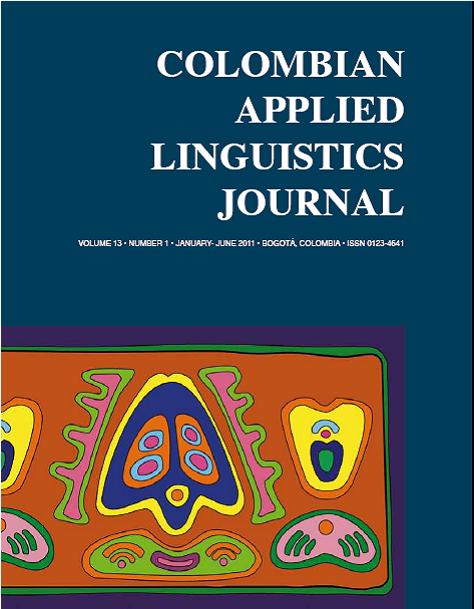DOI:
https://doi.org/10.14483/22487085.2928Published:
2011-01-01Issue:
Vol 13, No 1 (2011) January-JuneSection:
Research ArticlesConnecting knowledge for text construction through the use of graphic organizers
El uso de organizadores gráficos para la construcción de textos y la creación de conocimiento
Keywords:
Reconstrucción de textos, organizadores gráficos, conexión entre conocimiento previo y nuevo (es).Keywords:
texts reconstruction, graphic organizers, previous and new knowledge connections (en).Downloads
Abstract (en)
This study analyzed how basic level students comprehend short descriptive texts and rewrite their texts through the use of graphic organizers (GOs). The research was built upon the qualitative research paradigm with the inclusion of descriptive and introspective approaches. The study was carried out at a prestigious private school in Bogotá, Colombia, with basic English level II sixth graders. Data was gathered through focus groups, GOs, and students’ documents. The results of the study demonstrated that students made connections with previous knowledge acquired at school as part of the curriculum or at home as part of their daily experiences. Participants organized the information in principal and supporting ideas in order to comprehend and rewrite their texts. According to the results, the study found that learners have previous ideas or knowledge that let them complement, organize, or re-direct a given topic.
Abstract (es)
En este estudio se analizó cómo los estudiantes de inglés básico en grado sexto fueron capaces de comprender textos descriptivos cortos y verse ellos mismos como productores de textos haciendo uso de organizadores gráficos (OG). La investigación se realizó con base en el paradigma cualitativo con la inclusión de los enfoques descriptivo e introspectivo. El estudio se llevó a cabo en una prestigiosa escuela del sector privado en Bogotá, Colombia, con estudiantes de grado sexto del nivel básico de inglés. Los datos fueron recolectados usando tres instrumentos: grupos focales, organizadores gráficos y los documentos de los estudiantes. Los resultados del estudio demostraron que los estudiantes hacen conexiones entre el conocimiento previo que pudo ser adquirido en la escuela, como parte del currículo, o en la casa, como parte de su experiencia cotidiana. Los participantes organizaron la información en ideas principales e ideas secundarias con el propósito de comprender la lectura así como para re-escribir sus nuevos textos, lo cual permitió concluir que los estudiantes tienen ideas o conocimiento previo que les permite complementar, organizar, o re-direccionar un tema dado.
References
Alderson, C. (2000). Assessing reading. Cambridge: Cambridge University Press.
Brown, J. (2002). Understanding research in second language learning. Cambridge: Cambridge University Press.
Burns, A. (2001). Collaborative action research for English language teachers. Cambridge: Cambridge University Press.
Buzan, T. (1996). The mind map book. New York: Penguin Books.
Carretero, M. (2005). Constructivismo y educación. Buenos Aires: Editorial Luis Vives.
Campos, A. (2005). Organizadores gráficos. Técnicas visuales para aprender y enseñar. Revista Internacional del Magisterio. N° 18. Bogotá: Cooperativa Editorial del Magisterio.
DiCecco, V. & Gleason, M. (2002). Using GO to attain knowledge from expository text. Journal of Learning Disabilities. (35)4.
Gökler, F., Özay, E., Öztas, F., & Öztas, H. (2006). The improvement of ecology teaching in secondary school: effects of concept maps in the restructuring of previous knowledge. Journal of Science Education. (7)2. p. 115-118.
Goodman, K. (1996). On reading. Portsmouth: Heinemann.
Lankshear, C. & Knobel, M. (2004). A hand book for teacher renew search: from design to implementation. New York: Open University Press.
Lerner, D. (2001). Leer en la escuela: lo real, lo possible y lo necesario. México: Fondo de Cultura Económica. Ministerio de Educación Nacional. (2005). Bases para
una nación bilingüe y competitiva. Al tablero N° 37. Retrieved April 15 2009. From: http://www.mineducacion.gov.co/1621/article-97498.html
Moss, B. (2004). Teaching expository text structure through information trade book retellings. The Reading Teacher. (57)8. p. 710 – 718.
Nunan, D. (2002). Research methods in language learning. Cambridge: Cambridge University Press.
Omaggio, A. (1993). Teaching language in context. New York: Heinle & Heinle.
Wallace, J. (2002). Action research for language teachers. Cambridge: Cambridge University Press.
White, R., & Arndt, V. (1996). Process writing. Harlow: Longman.
How to Cite
APA
ACM
ACS
ABNT
Chicago
Harvard
IEEE
MLA
Turabian
Vancouver
Download Citation
Metrics
License
This work is licensed under a Creative Commons Attribution-NonCommercial-NoDerivatives 4.0 International License.
Attribution — You must give appropriate credit, provide a link to the license, and indicate if changes were made. You may do so in any reasonable manner, but not in any way that suggests the licensor endorses you or your use.
NonCommercial — You may not use the material for commercial purposes.
NoDerivatives — If you remix, transform, or build upon the material, you may not distribute the modified material.
The journal allow the author(s) to hold the copyright without restrictions. Also, The Colombian Apllied Linguistics Journal will allow the author(s) to retain publishing rights without restrictions.









